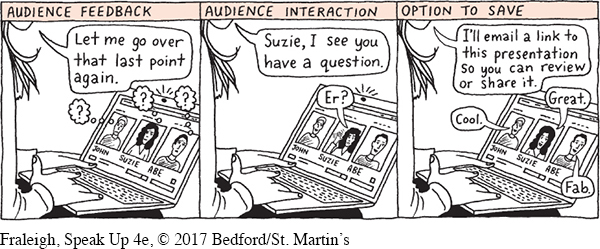Advantages of Real-Time Technologies
Video-based technologies such as videoconferencing, Webinars, and Skype allow speakers to communicate with audience members in diverse locations and in real time. The decision to use a real-time mediated format may depend on the purpose of the presentation. If the message is straightforward and not complex, this format is more likely to be appropriate.8 Videoconferencing is also more likely to be successful when participants have already met and built a relationship with one another.9 When participants are not acquainted, it may be more difficult for them to develop a sense of togetherness or cohesion in mediated formats.10
In any real-time mediated presentation, the technologies cannot create the sense of presence that comes when a speaker and an audience share the same physical space. However, they do allow for some of the benefits of a face-to-face speech, including audience feedback and audience interaction, and they offer the option to save.
Audience Feedback. Depending on the type of technology available, you might be able to experience audience feedback and adapt your speech in the moment. If you have the advantage of top-flight technology and large screens, you will be able to observe more of your audience’s nonverbal responses.11
Audience Interaction. Real-time technology allows audience members to interact with the speaker during or immediately after the speech. For example, there can be a question-and-answer session. Or if the speaker encourages it, audience members may ask questions during the presentation.
Page 443
Option to Save. An additional benefit to real-time presentations is that they often can be saved. Depending on what technology you use, audience members may have the ability to go back to any part of your speech if they didn’t understand something or want to reinforce the information shared. If you are able to record your real-time speech, you have the opportunity to share it with an even wider audience.
Now that we have considered some of the potential advantages to mediated presentations, let’s turn our attention to the main challenges.
